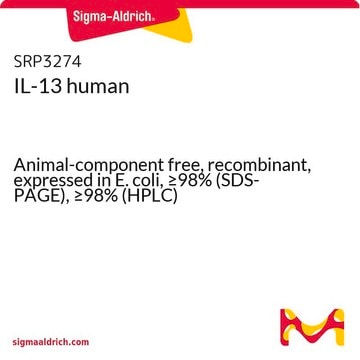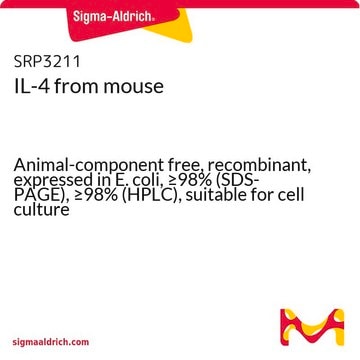SRP4166
IL-13 from rat
recombinant, expressed in E. coli, ≥95% (SDS-PAGE), ≥95% (HPLC)
Synonym(s):
ALRH, BHR1, IL-13, NC300, P600, interleukin 13
Sign Into View Organizational & Contract Pricing
All Photos(1)
About This Item
Recommended Products
biological source
rat
recombinant
expressed in E. coli
Assay
≥95% (HPLC)
≥95% (SDS-PAGE)
form
lyophilized
mol wt
~12.7 kDa
packaging
pkg of 10 μg
storage condition
avoid repeated freeze/thaw cycles
impurities
endotoxin, tested
NCBI accession no.
UniProt accession no.
shipped in
wet ice
storage temp.
−20°C
Gene Information
rat ... Il13(116553)
General description
IL13 (interleukin 13) is a classic cytokine produced by Th2 (T-helper) cells. It was originally identified as an inflammatory cytokine production-inhibiting T-cell derived cytokine. Recombinant rat IL-13 is an 11.9 kDa protein containing 109 amino acid residues.
Biochem/physiol Actions
IL13 (interleukin 13) is up-regulated during parasitic infections, and participates in host′s protective immunity against Schistosoma japonicum. This protein promotes eosinophil activation resulting in elevated specific IgE against adult and larval antigens. During acute infection it promotes egg expulsion through increased intestinal contractility. It acts as a liver protective agent where it promotes formation of liver granulomas in a CD4+ T cell-mediated manner, which results in liver fibrosis. In airway disorders, such as asthma, chronic obstructive pulmonary disease (COPD), and cystic fibrosis lung disease, IL13 promotes the formation of airway goblet cells, resulting in excess mucus secretion, which in turn, is regulated by IL13-activated autophagy.
Physical form
Sterile filtered and lyophilized with no additives.
Reconstitution
Centrifuge the vial prior to opening. Avoid freeze-thaw cycles.
Reconstitute in water to a concentration of 0.1-1.0 mg/mL. The solution can be diluted into other aqueous buffers.
Storage Class Code
11 - Combustible Solids
WGK
WGK 3
Flash Point(F)
Not applicable
Flash Point(C)
Not applicable
Certificates of Analysis (COA)
Search for Certificates of Analysis (COA) by entering the products Lot/Batch Number. Lot and Batch Numbers can be found on a product’s label following the words ‘Lot’ or ‘Batch’.
Already Own This Product?
Find documentation for the products that you have recently purchased in the Document Library.
IL13 activates autophagy to regulate secretion in airway epithelial cells.
Dickinson JD, et.al.
Autophagy, 12, 397-409 (2016)
IL-13 effector functions
Wynn TA
Annual Review of Immunology, 21, 425-456 (2003)
Gui Yang et al.
The Journal of biological chemistry, 290(20), 12858-12867 (2015-04-04)
Restoration of the antigen (Ag)-specific immune tolerance in an allergic environment is refractory. B cells are involved in immune regulation. Whether B cells facilitate the generation of Ag-specific immune tolerance in an allergic environment requires further investigation. This paper aims
Kihyuk Shin et al.
Clinical and experimental medicine, 15(3), 233-244 (2014-06-14)
The leukotrienes (LTs) enhance allergen- and interleukin (IL)-13-dependent allergic lung inflammatory disease. However, the precise requirement of LTs and the mechanism by which they elicit allergic lung responses remain uncertain. To clarify the involvement of LTs in respiratory allergen- and
John D Dickinson et al.
Autophagy, 12(2), 397-409 (2015-06-11)
Cytokine modulation of autophagy is increasingly recognized in disease pathogenesis, and current concepts suggest that type 1 cytokines activate autophagy, whereas type 2 cytokines are inhibitory. However, this paradigm derives primarily from studies of immune cells and is poorly characterized
Our team of scientists has experience in all areas of research including Life Science, Material Science, Chemical Synthesis, Chromatography, Analytical and many others.
Contact Technical Service








